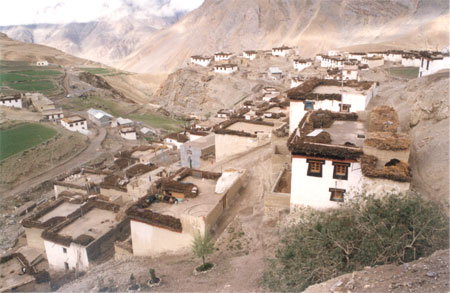
Spiti means middle country, a name given to it as a result of its ties with India and Tibet. A century ago, Rudyard Kipling in Kim called Spiti “a world within a world” and a “place where the gods live” – a description that holds good even today. Fed by several streams the Spiti river flows through the area to eventually join the Sutlej that starts from Mansrovar in Tibet. Buddhism is the pre-dominant religion there. Spiti can be reached from Manali or Simla.
From Manali one goes past Rohtang Pass to Grampu. We caught a 2 by 3 bus from here at 9 a.m. The terrain was amazing, barren not a patch of grass. In most places the kachha roads were so narrow that even a slight error in judgment could have resulted in the bus falling into the Valley. We could only admire the Himachal State Transport drivers. Excellent control and very level headed.
By lunchtime we reached Kulzum Pass (4551 metres) that divides Lahaul from Spiti Valley. The hills that were barren earlier now began to look beautiful. They had some sort of a symmetrical design, different colors and shapes. The hills were more mud and less rock. People were few and in between. What impressed me was that every village had lots of trees. After a grueling yet adventurous drive we reached Kaza at about 5 pm.
Besides being the administrative headquarters of Spiti Kaza has nothing much to offer. It is the base for going to Kibber Village, Pin / Lingti valleys and the world famous Ki gompa – monastery. At a distance of 18 kms from Kaza and a height of 4205 metres Kibber village is the second highest motorable road village in the world. Not only is it very clean but it also has a full-fledged school, two clean quality hotels and guess what a VSAT based telephone exchange. The local people looked happy and spoke Hindi and English fluently. Most housetops had dish antennas. When we walked into one of the houses the local women was seeing Sahara TV. When she got to know that we were from Mumbai she complained about missing her favorite programs on Zee Tv not knowing that Zee was no longer a free to air channel.
Ki Monastry was built before the 15th century and is some 13 kms from Kaza. It is a collection of rooms and a labyrinth of corridors that do not follow any defined plan, but seem to have grown over the years. It is the repository of rare thangka paintings and several ancient musical instruments. Its library holds the manuscripts of the sacred Tangyur texts. In an architectural sense there is nothing great about the monastery. However, you get an excellent view of Spiti valley from its rooftop. Like a monastery on the banks of Mansrovar in Tibet the Ki monastery too had a trishul on its rooftop. Tibetan Buddhists worship Lord Shiva with as great fervor as we Indians do.
Our next stop was Tabo. Founded in 996 A.D. at a height of 3050 meters Tabo has exquisite wall paintings and stucco statutes and is often called the Ajanta of the Himalayas. The complex has nine temples, 23 chortens, and caves. In Trans Himalayan Buddhism Tabo’s sanctity is next only to Tibet’s Tholing monastery. UNESCO has declared it as a World Heritage Site. Over a thousand years old yet the statues and paintings retain most of their original work. Unfortunately taking photographs inside the monastery is prohibited.
What looked like a small sleepy village in the midst of nowhere had many surprises for us. It has a PCO from where my friend called London and me Mumbai. Believe me we got through first attempt. It has a primary health care center and a provisions store that keeps 75 % of the goodies that we get at our kirana store in Mumbai. A woman runs Tabo’s most popular restaurant. She had a gas cylinder, mixer grinder and a washing machine too.
Inspite of being cut off by snow for nearly six months in a year the people seemed so content and happy. It is the first time that I have, in the Indian State come across people who have no complaints against the government. Most of them had only good things to say. Their words of appreciation will echo in my ears for years.
Since foreigners require a special permit to enter Lahaul and Spiti valley I was hoping to see a number of Indians there. To my utter surprise, besides the two of us a family of four from Chandigrah were the only Indian tourists that we met during a six-day stay. Spiti was however, filled with Israeli students. Apparently after a difficult but compulsory three-year military training students are looking for a respite. What better place than India? Its cheap, beautiful, a liberal society and has lots to offer. Himachal seems to be the flavor of the month because all through our Himachal trip we came across Israelis galore. In fact the menu card in Mcleodganj has Israeli dishes on it.
Having traveled extensively through Kashmir Valley and now Himachal Pradesh I would say that the latter is far more scenic. Unfortunately to most Indians Himachal is Simla at best Manali. Rohtang is about how far they would go. Beautiful as these places are I believe that the places to go are Dalhousie, Spiti and Kinnaur districts. The problem is that parts of Himachal were reserved areas till recently making it out of bounds for tourists. Also difficult terrain makes traveling within the state difficult. Most Indians want to travel in comfort refusing to rough it out.
I have not been commissioned by Himachal Tourism to say this but would say that our lives would be incomplete if we do not see Himachal Pradesh in totality.
More photos on esamskriti





